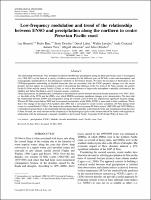| dc.contributor.author | Bourrel, L. | |
| dc.contributor.author | Rau, Pedro | |
| dc.contributor.author | Dewitte, Boris | |
| dc.contributor.author | Labat, David | |
| dc.contributor.author | Lavado-Casimiro, W. | |
| dc.contributor.author | Coutaud, Aude | |
| dc.contributor.author | Vera, Andrea | |
| dc.contributor.author | Alvarado, Abigail | |
| dc.contributor.author | Ordóñez Gálvez, Juan Julio | |
| dc.coverage.spatial | Peru | |
| dc.date.accessioned | 2021-07-01T15:51:48Z | |
| dc.date.available | 2021-07-01T15:51:48Z | |
| dc.date.issued | 2014-05-21 | |
| dc.identifier.uri | https://hdl.handle.net/20.500.12542/1026 | |
| dc.description.abstract | The relationship between El Niño Southern Oscillation (ENSO) and precipitation along the Peruvian Pacific coast is investigated
over 1964–2011 on the basis of a variety of indices accounting for the different types of El Niño events and atmospheric and
oceanographic manifestations of the interannual variability in the tropical Pacific. We show the existence of fluctuations in the
ENSO/precipitation relationship at decadal timescales that are associated with the ENSO property changes over the recent
decades. Several indices are considered in order to discriminate the influence of the two types of El Niño, namely, the eastern
Pacific El Niño and the central Pacific El Niño, as well as the influence of large-scale atmospheric variability associated to the
Madden and Julian Oscillation, and of regional oceanic conditions.
Three main periods are identified that correspond to the interleave periods between the main climatic transitions over 1964–2011,
i.e. the shifts of the 1970s and the 2000s, over which ENSO experiences significant changes in its characteristics. We show that
the relationship between ENSO and precipitation along the western coast of Peru has experienced significant decadal change.
Whereas El Niño events before 2000 lead to increased precipitation, in the 2000s, ENSO is associated to drier conditions. This is
due to the change in the main ENSO pattern after 2000 that is associated to cooler oceanic conditions off Peru during warm
events (i.e. central Pacific El Niño). Our analysis also indicates that the two extreme El Niño events of 1982/1983 and 1997/1998 have overshadowed actual trends in the relationship between interannual variability in the tropical Pacific and precipitation along the coast of Peru. Overall, our study stresses on the complexity of the hydrological cycle on the western side of the Andes with regard to its relationship with the interannual to decadal variability in the tropical Pacific. | es_PE |
| dc.format | application/pdf | es_PE |
| dc.language.iso | spa | es_PE |
| dc.publisher | John Wiley and Sons | es_PE |
| dc.relation.uri | https://onlinelibrary.wiley.com/doi/epdf/10.1002/hyp.10247 | es_PE |
| dc.rights | info:eu-repo/semantics/openAccess | es_PE |
| dc.rights | Reconocimiento - No comercial - Sin obra derivada (CC BY-NC-ND) | es_PE |
| dc.rights.uri | https://creativecommons.org/licenses/by-nc-nd/4.0/ | es_PE |
| dc.source | Repositorio Institucional - SENAMHI | es_PE |
| dc.source | Servicio Nacional de Meteorología e Hidrología del Perú | es_PE |
| dc.subject | ENSO | es_PE |
| dc.subject | Precipitación | es_PE |
| dc.subject | Pacific Coast | es_PE |
| dc.subject | Trend | es_PE |
| dc.subject | Climatología | es_PE |
| dc.title | Low-frequency modulation and trend of the relationship between ENSO and precipitation along the northern to centre Peruvian Pacific coast | es_PE |
| dc.type | info:eu-repo/semantics/article | es_PE |
| dc.contributor.email | Bourrel, Luc | |
| dc.identifier.doi | https://doi.org/10.1002/hyp.10247 | |
| dc.identifier.journal | Hydrological Processes | es_PE |
| dc.subject.ocde | https://purl.org/pe-repo/ocde/ford#1.05.11 | es_PE |
| dc.subject.ocde | https://purl.org/pe-repo/ocde/ford#1.05.10 | es_PE |
| dc.subject.sinia | fenomeno El Niño - Clima y Eventos Naturales | es_PE |
| dc.type.sinia | text/publicacion cientifica | es_PE |
| dc.identifier.url | https://hdl.handle.net/20.500.12542/1026 | |









